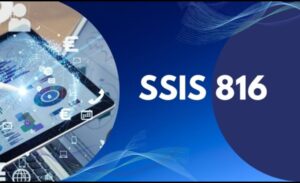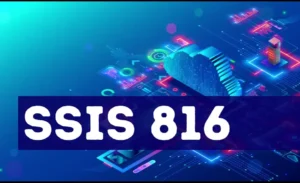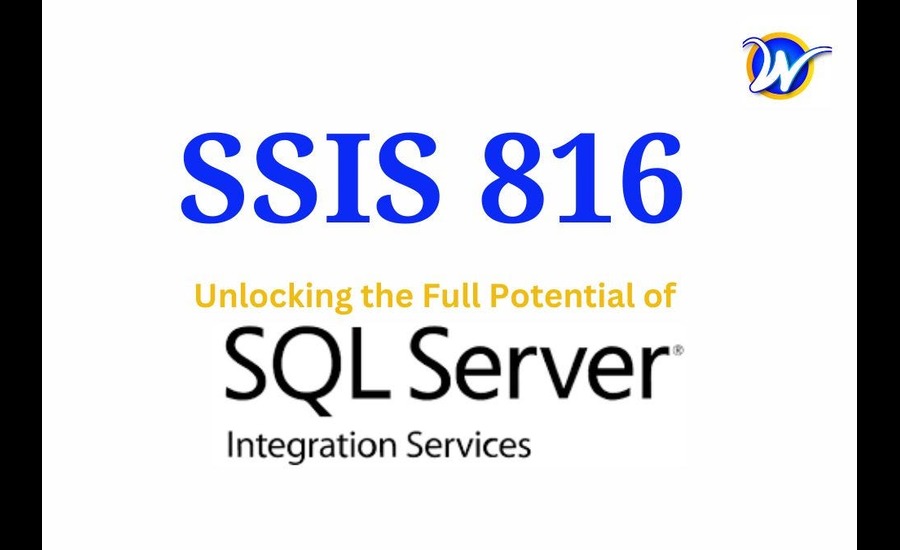SSIS 816: Unveiling Its Advantages for Comprehensive Learning
SQL Server Integration Services (SSIS) has long been a staple in the toolkit of data professionals for its robustness and versatility in handling data extraction, transformation, and loading (ETL) tasks. With the advent of SSIS 816, a significant update has been introduced, bringing with it a host of new features and enhancements designed to streamline and optimize data workflows. This comprehensive guide delves into the latest features and updates of SSIS 816, providing a detailed analysis of how these changes can benefit users and improve their ETL processes.
Understanding SSIS 816: An Overview
SSIS 816 represents a significant leap forward from its predecessors, incorporating advancements that cater to the evolving needs of data management. The update focuses on enhancing performance, scalability, and usability, ensuring that SSIS remains a competitive choice in the ETL landscape. This section provides an overview of what SSIS 816 entails, highlighting its core objectives and the motivations behind its development.
The primary aim of SSIS 816 is to address the challenges posed by large-scale data integration projects. As organizations increasingly rely on big data and complex data ecosystems, the need for a more powerful and flexible ETL tool has become evident. SSIS 816 rises to the occasion with features that enhance its capability to handle vast amounts of data efficiently while maintaining high performance and reliability.

Enhanced Performance and Scalability
One of the most notable improvements in SSIS 816 is its enhanced performance and scalability. The latest version introduces several optimizations that significantly reduce processing times and improve overall efficiency. These enhancements are particularly beneficial for organizations dealing with large datasets and complex ETL workflows.
SSIS 816 incorporates advanced parallel processing techniques, allowing for the simultaneous execution of multiple tasks. This feature maximizes resource utilization and minimizes idle times, leading to faster data processing. Additionally, the update includes improvements to the data flow engine, optimizing data movement and transforming operations to further enhance performance.
Scalability has also been a key focus in the development of SSIS 816. Therefore, the update introduces new features that enable seamless scaling of ETL processes, accommodating growing data volumes and increasing workload demands. These scalability enhancements ensure that SSIS can efficiently handle the ever-expanding data requirements of modern organizations.
Improved Usability and User Experience
SSIS 816 places a strong emphasis on improving usability and user experience, making it more accessible and intuitive for data professionals of all skill levels. The update includes a range of new features and enhancements designed to simplify the development and management of ETL workflows.
One of the standout features of ssis-816 jav is the revamped user interface (UI). The new UI offers a more modern and streamlined design, providing a visually appealing and user-friendly environment. The update also introduces enhanced drag-and-drop functionality, making it easier to create and modify data flows and transformations.
In addition to the UI improvements, SSIS 816 offers enhanced debugging and error-handling capabilities. The update includes new debugging tools that provide more detailed insights into ETL processes, helping users identify and resolve issues more efficiently. Enhanced error-handling features ensure that ETL workflows can recover from failures gracefully, minimizing disruptions and downtime.

Advanced Data Integration Capabilities
SSIS 816 introduces several advanced data integration capabilities, expanding its ability to handle diverse data sources and formats. The update includes new connectors and adapters that enable seamless integration with a wider range of data platforms, including cloud-based services and big data technologies.
One of the key additions in SSIS 816 is support for Apache Spark, a popular big data processing framework. This integration allows users to leverage the power of Spark for large-scale data processing, enabling faster and more efficient ETL workflows. SSIS 816 also includes enhanced support for cloud-based data sources, such as Azure Data Lake Storage and Amazon S3, providing greater flexibility in data integration scenarios.
Furthermore, SSIS 816 introduces new data transformation capabilities, enabling more complex and sophisticated data manipulation. The update includes a range of new transformation components, such as advanced data cleansing and enrichment tools, which enhance the quality and accuracy of integrated data. These advanced data integration capabilities ensure that SSIS remains a versatile and powerful tool for modern data management needs.
Integration with Machine Learning and AI
Recognizing the growing importance of machine learning (ML) and artificial intelligence (AI) in data management, SSIS 816 introduces features that facilitate the integration of ML and AI capabilities into ETL workflows. The update includes new components and connectors that enable seamless integration with popular ML and AI platforms, such as Azure Machine Learning and TensorFlow.
SSIS 816 allows users to incorporate ML models and algorithms into their ETL processes, enabling advanced data analysis and predictive analytics. This integration provides a powerful tool for organizations looking to derive deeper insights from their data and make more informed business decisions. The update also includes enhancements to the data flow engine, optimizing the performance of ML and AI operations within ETL workflows.

Enhanced Security and Compliance
Security and compliance have always been critical considerations in data management, and SSIS 816 addresses these concerns with a range of new features and enhancements. The update introduces advanced security measures that ensure the protection of sensitive data throughout the ETL process.
SSIS 816 includes support for advanced encryption algorithms, enabling secure data transmission and storage. The update also introduces enhanced authentication and authorization mechanisms, providing granular control over access to ETL workflows and data sources. These security enhancements ensure that SSIS 816 complies with industry standards and regulations, providing peace of mind for organizations handling sensitive data.
In addition to security enhancements, SSIS 816 includes features that facilitate compliance with data governance and privacy regulations. The update introduces new data masking and anonymization capabilities, enabling the protection of personally identifiable information (PII) and other sensitive data. These compliance features ensure that SSIS 816 can be used in regulated industries, such as healthcare and finance, where data privacy and security are paramount.
Improved Connectivity and Integration with Azure
Furthermore, as more organizations adopt cloud-based data platforms, the need for seamless integration with cloud services has become increasingly important. Ssis-816 jav addresses this need with enhanced connectivity and integration features that enable seamless interaction with Microsoft Azure.
The update includes new connectors and adapters for Azure services, such as Azure SQL Database, Azure Data Factory, and Azure Blob Storage. These connectors enable users to easily integrate data from Azure-based platforms into their ETL workflows, providing greater flexibility and scalability. SSIS 816 also includes support for Azure Data Lake Analytics, enabling users to leverage the power of big data analytics in their ETL processes.
Furthermore, SSIS 816 introduces enhanced support for hybrid data integration scenarios, enabling seamless data movement between on-premises and cloud-based environments. This hybrid integration capability ensures that SSIS can accommodate diverse data integration needs, providing a versatile solution for modern data management.
Streamlined Deployment and Management
SSIS 816 includes a range of features designed to streamline the deployment and management of ETL workflows. The update introduces new deployment options and management tools that simplify the process of deploying and maintaining SSIS packages.
One of the key additions in SSIS 816 is support for containerization and orchestration platforms, such as Docker and Kubernetes. This feature enables users to deploy SSIS packages in containerized environments, providing greater flexibility and scalability. The update also includes enhancements to the SSIS catalog, providing more advanced management and monitoring capabilities.
SSIS 816 introduces new deployment automation tools that simplify the process of deploying and updating SSIS packages. These tools enable users to automate the deployment process, reducing manual effort and minimizing the risk of errors. Additionally, the update includes enhanced logging and monitoring features, providing more detailed insights into the performance and status of ETL workflows.

Advanced Data Quality and Profiling
Data quality is a critical aspect of any ETL process, and SSIS 816 introduces several features that enhance data quality and profiling capabilities. The update includes new data cleansing and validation components that ensure the accuracy and reliability of integrated data.
SSIS 816 introduces advanced data profiling tools that provide detailed insights into the quality and characteristics of data. These tools enable users to identify data quality issues, such as missing or inconsistent values, and take corrective actions. The update also includes enhanced data cleansing components, such as fuzzy matching and data standardization tools, that improve the quality and consistency of integrated data.
In addition to data cleansing and profiling, SSIS 816 introduces new data enrichment capabilities that enhance the value and usability of integrated data. These capabilities include integration with external data sources, such as reference data and third-party data services, enabling users to enrich their data with additional context and information.
Enhanced Collaboration and Integration with DevOps
Furthermore, collaboration and integration with DevOps practices are increasingly important in modern data management, and SSIS 816 introduces features that facilitate these practices. The update includes new collaboration tools and integration with popular DevOps platforms, such as Azure DevOps and GitHub.
SSIS 816 introduces enhanced version control and source code management capabilities, enabling teams to collaborate more effectively on ETL projects. These capabilities include support for branching and merging, enabling users to manage multiple versions of SSIS packages and collaborate on changes. The update also includes integration with continuous integration and continuous deployment (CI/CD) pipelines, enabling automated testing and deployment of SSIS packages.
Furthermore, SSIS 816 introduces new collaboration tools that facilitate communication and coordination among team members. These tools include enhanced project management features, such as task tracking and issue management, that enable teams to manage their ETL projects more efficiently. The update also includes support for real-time collaboration, enabling team members to work together on SSIS packages simultaneously.
Future Prospects and Trends in SSIS
As we look to the future, it is clear that SSIS will continue to evolve to meet the changing needs of data management. The advancements introduced in SSIS 816 provide a glimpse into the future direction of the platform, highlighting key trends and areas of focus.
One of the key trends in the future of SSIS is the increasing integration with cloud-based platforms and services. As more organizations adopt cloud computing, the need for seamless integration with cloud data sources and services will continue to grow. SSIS will likely continue to enhance its connectivity and integration capabilities, enabling users to leverage the power of cloud-based data management.
Another key trend is the growing importance of machine learning and artificial intelligence in data management. As organizations seek to derive deeper insights from their data, the integration of ML and AI capabilities into ETL workflows will become increasingly important. SSIS will likely continue to enhance its support for ML and AI, providing more advanced tools and capabilities for data analysis and predictive analytics.
In addition to these trends, the future of SSIS will likely include continued advancements in performance, scalability, and usability. The platform will continue to evolve to meet the growing demands of large-scale data integration projects, providing more powerful and flexible tools for data professionals.
Conclusion
SSIS 816 represents a significant milestone in the evolution of SQL Server Integration Services, introducing a host of new features and enhancements that cater to the needs of modern data management. The update focuses on enhancing performance, scalability, usability, and security, ensuring that SSIS remains a competitive choice in the ETL landscape.
From advanced data integration capabilities to improved usability and user experience, SSIS 816 offers a range of enhancements that streamline and optimize ETL workflows. The update introduces features that facilitate the integration of machine learning and artificial intelligence, enhance security and compliance, and improve connectivity with cloud-based platforms. Additionally, SSIS 816 includes tools that streamline the deployment and management of ETL workflows, enhance data quality and profiling, and facilitate collaboration and integration with DevOps practices.
As we look to the future, it is clear that SSIS will continue to evolve to meet the changing needs of data management, with trends such as increased integration with cloud platforms and the growing importance of ML and AI shaping its development. With SSIS 816, data professionals have a powerful and versatile tool that enables them to tackle the challenges of modern data integration and drive their organizations towards success.
FAQs:
What is SSIS 816?
SSIS 816 is the latest version of SQL Server Integration Services, a platform for building enterprise-level data integration and data transformation solutions. This update includes significant improvements in performance, scalability, usability, and security, along with new features that cater to modern data management needs.
What are the key features of SSIS 816?
The key features of SSIS 816 include enhanced performance and scalability, improved usability and user experience, advanced data integration capabilities, integration with machine learning and AI, enhanced security and compliance, improved connectivity and integration with Azure, streamlined deployment and management, advanced data quality and profiling, and enhanced collaboration and integration with DevOps practices.
How does SSIS 816 improve performance and scalability?
SSIS 816 improves performance and scalability through advanced parallel processing techniques, an optimized data flow engine, and features that enable seamless scaling of ETL processes. These enhancements reduce processing times, maximize resource utilization, and ensure efficient handling of large data volumes and complex workflows.
What usability improvements are included in SSIS 816?
Usability improvements in SSIS 816 include a revamped user interface with a modern and streamlined design, enhanced drag-and-drop functionality, improved debugging and error-handling capabilities, and new tools that provide detailed insights into ETL processes.
What are the advanced data integration capabilities of SSIS 816?
The advanced data integration capabilities of SSIS 816 include new connectors and adapters for a wider range of data platforms, support for Apache Spark, enhanced support for cloud-based data sources like Azure Data Lake Storage and Amazon S3, and new data transformation components that enable more complex data manipulation.
How does SSIS 816 integrate with machine learning and AI?
SSIS 816 integrates with machine learning and AI by providing new components and connectors for popular ML and AI platforms such as Azure Machine Learning and TensorFlow. Users can incorporate ML models and algorithms into ETL processes for advanced data analysis and predictive analytics.






